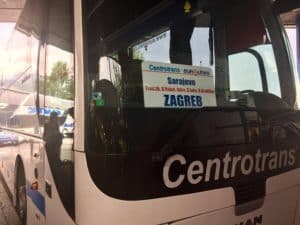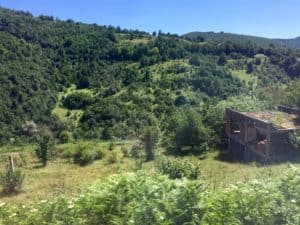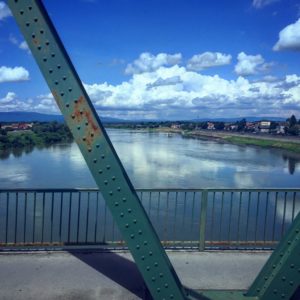Last Updated on June 3, 2023 by Ellen
Bosnian mountains and forests are gorgeous, but the terrain makes traveling by bus a long ride from Croatian cities to Sarajevo.
This post will focus on the bus option, because that’s what we used as budget travelers. I will also cover what happens at the border, update information about the train situation over the northern border between these countries, and mention other travel options.
Bus rides over the Croatian-Bosnian border
We took the bus from Split, Croatia, to Sarajevo, Bosnia, and it took more than seven hours to go roughly 155 miles. The road curves over the mountains and through the forests on a two-lane road. We rarely went over 45 miles per hour.
Tickets for this ride were $34 each, and this was the lowest priced option. It was with the Globtours company. (But going from Sarajevo to Split, the price was only $25.)
We also went from Sarajevo to Zagreb, Croatia and back to Sarajevo. That trip is 250 miles, and takes more than nine hours. It would have taken longer, but the last 50 miles or so are on a straight and modern four lane highway instead of a curving mountain road. Tickets for this ride were $34 USD each, and there was only one option.
Buy tickets at the bus station in the city of your departure. Try to buy tickets a day early. The bus was nearly empty by the time it got to Sarajevo, but the beginning of the trips were sometimes nearly full. From Split to Sarajevo, there were about four buses daily. The same number of buses left Sarajevo each day for Zagreb.

More tips from our experience:
- Make sure you pick a seat with clean windows. You’ll get better views, better pictures. Some windows are clouded up with some kind of funk or grease.
- Don’t worry too much about seat numbers. Sometimes tickets assign you a seat number, but there aren’t always numbers on the seats. Of course, if your seat is clearly marked, sit somewhere else at your own risk.
- Don’t expect to stop for potty time often. The bus doesn’t stop for two or three hours for bathroom breaks, depending on the route. If you’re like me, and have a small bladder, you want to stop drinking liquids a few hours before this long-ass bus ride. With all of that back and forth on the curvy road, well, three hours can seem like an eternity.
- Bring snacks. At least once during each of our trips, the bus driver stopped for 20 or 30 minutes at a restaurant/rest stop kind of place that sold food. It might not be the kind of food you want, however.
- Bring a book, or music. I read the fantastic novel The Cellist of Sarajevo on one of our trips from Sarajevo to Zagreb.
Again- the scenery is stunning. From forests to cliffs to rivers to fields, it’s a beautiful ride to Sarajevo from both Split and Zagreb, the latter landscape being more varied.

If you really search the landscape, especially closer to Sarajevo, you will see war damage. Damaged and abandoned buildings dot the landscape as a reminder the Bosnian War happened all over the region – not just Sarajevo.
You also will see churches and mosques in towns and villages throughout the countryside. A reminder on how people with different beliefs and cultures still co-exist in this country, despite the horrific ethnic cleansing during the war.
Border crossing
When you enter either Bosnia or Croatia, everyone gets off the bus and stands before an immigration officer for the proper stamp into the country. On the way out of Bosnia, this was different. Once, I was not stamped out of Bosnia; twice, my husband was not stamped out.
We aren’t sure why – but I will guess it’s because the border workers were overwhelmed and understaffed and since they are scanning ID anyway, who has time to bother with the old-fashioned stamp out? The worker comes onto the bus and collects everyone’s passport and eyes you up. After several minutes, the bus driver returns with the passports and hands them back out to people.
The border crossing can take anywhere from 20 minutes to an hour, depending on what day and what time you cross, with weekdays being less of a wait.
The border on the way to Zagreb is the Sava River at Gradiska on the Bosnian side, and Stara Gradiska on the Croatian side. Stara Gradiska is of notorious fame – where a World War II concentration and extermination camp killed Jewish women and children.

Train route
There used to be a train that crossed the northern border on the way to Zagreb, but that is no longer an option due to some kind of political issue between the two countries involving the crossing. We double checked at the Sarajevo train station after Tedly found conflicting information online. So as of this writing, there is no direct train route.
You could theoretically take a train from Sarajevo to a Bosnian town near the border, then take a cab over the border, and then get back on another train on the Croatian side. But you’re not going to save any time or money this way.
A few more options…
You’ll save a little time from Split to Sarajevo or Sarajevo to Zagreb if you rent a car, but keep in mind you’re crossing borders in a rental car, and it’s still a long drive on mountain roads. I have a girlfriend who rented a car and drove solo to Sarajevo from Croatia with absolutely no problem, so it seems to be pretty safe.
I’ll just mention flights because the cost seems to be $200 or more for a short flight, and this is a budget travel blog. Besides, you’d miss seeing the Bosnian countryside.
No matter how you cross the border, enjoy the ride.
🙂
Related:
Earth Vagabonds Newsletter


I travelled in all these places when they were part of one country- Yugoslavia. Crossing, for example, from Bosnia to Croatia was without any formalities. Thanks for your blog articles.